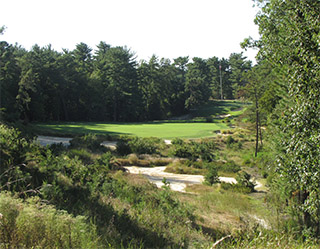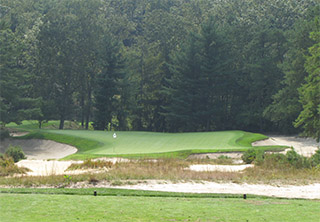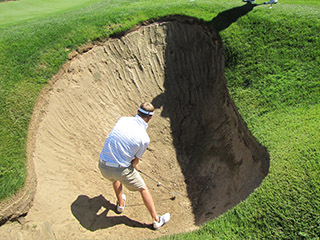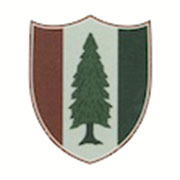
Pine Valley's 12th hole (Sean Melia Photo)
Editors note: this article was originally published in 2017 -- but it rings true today. With the Crump Cup coming in just over a week we thought it would be a good time to revisit the story.
PINE VALLEY, NJ - No one just stumbles across Pine Valley Golf Club. It sits at the end of a single lane road with little to suggest that the world's best golf course might be nearby.
There are no signs. There is hardly a glimpse of the course through the tall pines that over the years have grown to envelop what used to be open sandy pine barrens, over which club founder and course architect George Arthur Crump gazed on train rides to and from the Jersey shore from nearby Philadelphia.
Even when one reaches the end of that single lane road, there are few clues about what lies beyond the railroad tracks and past the by entrance gate.
Before smart phones, mapping apps and driving directions, there would be almost no way to find Pine Valley without inside information. It was almost as if the club didn't want to acknowledge to the outside world that it exists.
 |
Not many people get to stand where this
picture was taken, the back tee of
#18 at Pine Valley (Randy Haag photo) |
And so it was with its biggest annual event, the George A. Crump Memorial Tournament, better known as the Crump Cup. For years, it was the mysterious event that the most highly competitive mid-amateurs and seniors had heard about, the best of the "cocktail circuit" of tournaments held at the most exclusive clubs on the east coast--places like Seminole, Merion, National Golf Links of America, Fisher's Island, Garden City, and so on.
Locals have known about the tournament, and how for one half-day every year, Pine Valley opens up the gate for spectators to watch the championship match of the Crump Cup. But for the rest of the world, quite possibly the best amateur golf tournament on quite possibly the best golf course in the world was practically unknown.
With the advent of the internet and smart phones, and the rapid exchange of information and imagery, more and more people are getting to know about Pine Valley and the Crump Cup. The Pine Valley staff has been very accommodating in sharing results of the tournament with AmateurGolf.com and other outlets, and other places like Randy Haag's Golf Blog (Haag is a two-time Crump Cup champion) have given a peek behind the curtain during tournament week.
Still, for a tournament that may well be the best of its kind in the world, very few people know much about it.
The Golf Course
So what makes the Crump Cup at Pine Valley the best tournament that hardly anyone knows about?
Start with the golf course, which for many is shrouded in mystery. Most people see Pine Valley ranked #1 on various golf course ranking lists, but those lists give no indication of what makes the course unique and special.
We get to see courses like St. Andrews and Muirfield during the British Open; Shinnecock Hills, Merion, Pebble Beach, and Oakmont during the U.S. Open; and even exclusive places like the National Golf Links of America at the Walker Cup. But we don't get to see Pine Valley. There was a Shell's Wonderful World of Golf match between Byron Nelson and Gene Littler from 1962 that was re-aired a several years ago, and the 1985 Walker Cup match was played at Pine Valley, but there is little else that we have seen of the course on TV or the internet.
 |
#3 at Pine Valley with its banked
green (Randy Haag photo) |
The first thing to know about Pine Valley is that the ground on which it sits is ideal for golf, sharing the most important trait found at all the great seaside courses of Great Britain and Ireland--sandy soil.
Next is the amazing set of greens. From the long angled tabletop at the 1st to the elevated "ocean waves" green of the 2nd, to the right-to-left banked drop shot green at the 3rd, to the fallaway green at the 4th, to the steeply pitched green at the all-world 5th, and on and on, the greens at Pine Valley are so full of slope and character that there is almost no ordinary hole locations.
Pine Valley is a huge property, and the scale of the place hits you as you take the entrance drive across the 18th fairway--the wide corridors, the towering trees, the size of the hazards. Several high ridges create significant elevation changes, and the course traverses them in such a way that the player feels like he is on a journey across the property instead of moving back and forth across the same area.
 |
The angle of this photo tells all you need
to know about how deep the Devil's
A**hole bunker is (Randy Haag photo) |
Next are the scale and severity of its hazards, most of which are in the form of sand, but which range from tiny little scrapes to sprawling wastelands. Golf writers of the past first told the world about the famous hazards of Pine Valley, from Hell's Half-Acre on the 7th to the Devil's A**hole, the pot bunker on the 10th so deep that many golfers are unable to extract the ball at all. There are no rakes at Pine Valley; the sandy areas and bunkers found throughout the course are true hazards.
Pine Valley is a difficult golf course, and George A. Crump wanted it that way. There was a standing bet that no one could break 80 the first time he played it, and that bet was safe for the vast majority of new players for years. With today's equipment, players have more of a chance than they ever have of going low, and yet every year at the Crump Cup, the best mid-amateur and senior players rarely match or break par in stroke play qualifying.
Though it does have a lake that comes into play on the par-3 14th, and for truly errant shots to the right of #16, Pine Valley does not rely on water or OB for its difficulty. In fact there is no out of bounds at all, and structures including the clubhouse are considered through the green. There was a video that circulated from the 2012 Crump Cup where Carlton Forrester hit his second shot on the long par-four 4th on the clubhouse roof, from which he got up-an-down for an all-world par.
Most of all Pine Valley is a retreat from a busy and congested world, a place where time slows down and tranquility and solitude are allowed to be felt again. Once on property, it really does feel as if you have left the "real world" and entered a fantasy land of golf as it used to be.
The Exclusivity
Here too the Crump Cup has been somewhat of a mystery for competitive mid-amateurs and seniors wishing to some day walk Pine Valley and compete in the Crump Cup. There is no asking to get into the field. There are no applications, no open qualifiers. If Pine Valley wants you in the field and there is an opening, you will be invited.
You can also be un-invited. Players are on their best behavior, and are told in unequivocal terms that the tournament is for gentlemen. Unbecoming conduct is the best way to be permanently removed from the field, and the definition of unbecoming conduct is stricter here than perhaps anywhere else.
That's not to say that it is a tournament that has everyone walking around on eggshells; on the contrary it is a very social tournament known for its camaraderie and opportunities to spend time with fellow players. But it probably isn't the tournament for PGA Tour-level grinders, those with temper problems, or those with self-discipline issues.
The other way to be un-invited is to play your way out. Two years in a row of poor play and a finish near the bottom of the standings usually means another player will take your place in the field.
The Tradition
The Crump Cup has been contested since 1922, four years after George A. Crump's death. Early champions included Francis Ouimet (twice) and Chick Evans. Jay Sigel has the most Crump Cups, winning nine from 1975 to 1993. It has become harder and harder to win multiple Crump Cup titles, but Mike McCoy did win four times in seven years from 2004 to 2010.
The competition calls for 36 holes of stroke play qualifying, after which the mid-amateur field is cut to three match play flights of 16 players each, and the senior field is cut to two match play flights of 8 players each. Only those in the top flight have a chance at the overall championship, which is why the playoff for the final spots is one of the more exciting moments of the tournament week.
 |
The Pine Valley logo |
The tournament dinner is held the evening before match play starts, and the 16 players who have made the championship flight are given seats of honor at a long table at the front of the room, elevated above the rest of the players. Each player receives a Pine Valley flag corresponding to his match play seeding; the medalist gets the flag from the first hole, and so on. The flag theme is repeated if a player should score a hole-in-one, and there are prizes awarded for other feats like making an eagle (which is hard to do at Pine Valley considering neither par five is reachable, and only one par four is remotely driveable).
Every flight is competitive, and it is not rare for the 3rd flight to have three USGA champions in it. For those who miss out on making a match play flight, the club creates a competition for those players on the weekend. Sometimes it is a medal play competition on the par-3 course (which features realistic copies of several holes on the big course), sometimes a match play competition on the big course. So everyone has a chance to play golf through the weekend in some form or another.
In addition to the coat-and-tie tournament dinner, there is also a barbecue social, and other opportunities for socializing. Many players stay on site, some in the few houses that dot the property, more in the "dorms", a building between the fourth and fifth holes that is straight out of 1930--no TVs, no amenities of any kind, shared bathrooms. A few players will stay in small rooms in the clubhouse itself. It is not the tournament to go stay in the room, watch TV and work on your backswing in the hotel mirror.
The Crump Cup is a walking tournament, and players take caddies for every round. Again, not the tournament for the loner or the grinder who wants to carry his own bag and keep to himself.
Two matches are played Saturday to pare the championship flight down to four players, with two more on Sunday including the championship match in the afternoon.
This is when the gates are opened and the public is allowed in for their annual glimpse of the course and the conclusion of the tournament. These spectators pay a parking and shuttle bus fee, with proceeds benefiting the Clementon Youth Athletic Association.
They can see more than just the championship match; the final matches of the other flights are being contested concurrently, and so it isn't just one mass of people on the golf course. Many people, especially golf course architecture buffs, will wander away from the golf just to see the course itself, and take a closer look at each of the holes.
But no cameras are allowed, no video recorders, no cell phones. Just an invitation to take it all in with your own senses, and preserve a little of the mystery for the next ones to get to experience Pine Valley for the first time.
ABOUT THE
Crump Cup
The George A. Crump Memorial Tournament --
named
for the
hotelier and course architect most famous for
building
Pine Valley -- is arguably the premier mid-
amateur
event in the United States. The invitational field
is
made of of top players from around the United
States
and the UK. The format for the four days is two
rounds
of stroke play qualifying, followed by four
rounds
of
match play. Players are flighted according to
their
qualifying position, and a separate Senior flight
includes three of those flights. Jay Sigel has won
the
event the most times, with nine victories
between
1975 and 1993.
Normally, the public is invited to attend the Sunday
final matches but that tradition has been suspended.
View Complete Tournament Information